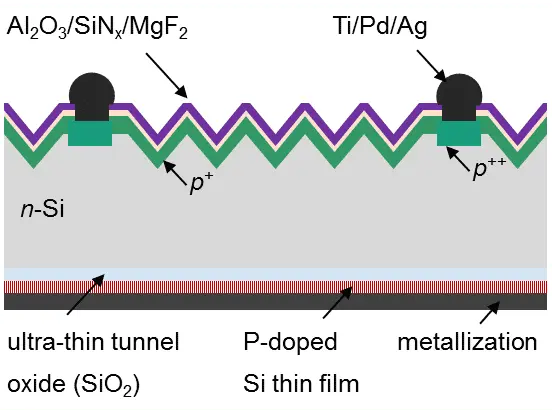TOPCon solar cells

TOPCon solar cells are the innovative new stars of the photovoltaic industry. Although new to the market, some manufacturers are already using this technology because it is truly groundbreaking. As pioneers of solar solutions we continue to develop and test our panel portfolio to ensure we offer the very best in quality for our customers. Find out more about TOPCon solar cells and learn about the advantages they can offer.
How do TOPCon solar cells work?
The term TOPCon stands for Tunnel Oxide Passivated Contact and describes the specific structure of a solar cell. The novel cell architecture was presented by researchers at the Fraunhofer Institute for Solar Energy Systems in Freiburg in 2013 , but it still took a few years until the first TOPCon modules came onto the market.
The basic idea of the TOPCon concept is that the metal of the connection contacts does not come into contact with the silicon layer. This prevents charge carrier recombination, which typically causes performance losses at the rear of the cell.
To prevent recombination, a very thin layer of silicon oxide (just a few nanometers) is applied to the surface of the solar cell. This SiO₂ layer passivates the surface, i.e. it blocks the passage of a type of charge carrier. However, the layer is so thin that the current can “tunnel through” quantum mechanically. In addition to this “tunnel layer”, another layer of highly doped silicon is inserted, which improves electrical conductivity and reduces transmission losses.
TOPCon solar cells - Breakthrough for n-type cells
Silicon cells are made up of an n-layer (negative, electron-conducting) and a p-layer (positive, “holes” = unoccupied charges). These layers have different thicknesses, with the thicker layer (the base) determining whether one speaks of p-type or n-type solar cells.
For many years, p-type cells dominated the solar industry because they are easier to manufacture. However, more and more photovoltaic manufacturers are now relying on n-cells because they promise higher efficiencies and therefore greater efficiency and are less susceptible to power losses. With p-type cells, for example, there are always losses in performance when sunlight hits the modules for the first time. This is referred to as “initial degradation”, which is triggered by chemical reactions in the cell.
Additional advantages of n-type cells include lower susceptibility to metallic impurities in silicon, lower power-induced degradation (PID) and higher temperature resistance. The solar cells also have a low-temperature coefficient, which means that performance decreases only slightly when temperatures rise.
However, the TOPCon technology is still quite new and there is evidence that solar cells have many advantages as well as disadvantages. The TOPCon technology appears to be susceptible to UV-induced degradation (UVID) , which could affect the service life of the modules.

Easy changeover to TOPCon possible
The TOPCon cells are the first solar cells that are preferably manufactured industrially as n-type cells. One advantage of the new technology is that existing lines can be easily upgraded to produce PERC cells. This allows the costs of introducing the technology to be kept comparatively low. TOPCon modules can be manufactured as bifacial half-cell modules in accordance with current standards.
The manufacturing costs for the new modules are still higher than for conventional PERC solar modules. Whether TOPCon prevails on the market depends on two factors. On the one hand, there is the scaling effect, i.e. lower unit costs can be achieved through a higher production volume. On the other hand, the higher efficiency (25% and more) and the resulting higher performance must be sufficient to increase revenue accordingly. As is well known, the price of modules depends on the output in Wp and the photovoltaic industry can only refinance its investments in the promising TOPCon technology through additional income. Developments such as the substitution of silver contacts with copper make the new solar modules even more attractive.


